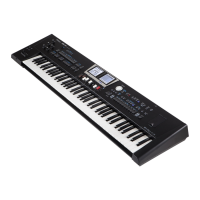‘Performance Edit’ parameters
131
Parameter Setting Explanation
C1 0~127
The function of this parameter depends on
the sound you assigned to the selected part. It
may inuence the lter and resonance setting,
switch between the organ samples with the
fast and slow Rotary modulation, etc.
SuperNATURAL Edit (Only if a SuperNATURAL tone is
selected)
You can make parameters settings for the selected SuperNATURAL
instrument.
Refer to “SuperNATURAL INST Parameters” in the “Tone & Drum Kit
List “ supplementary manual.
Download it from the Web http://www.roland.com/manuals/).
‘Tone Part Eects’ parameters
This function group can be selected using [MENU] button “Performance
Edit” “Tone Part Eects” or pressing and holding the [MFX] button. Your
BK-9 contains two multi-eects processor that can be used for processing
any keyboard part you like.
MEMO
There are also 3 multi-eects processors (“Mfx”), one reverb
processor and one chorus processor that can be used to process
Rhythm or Standard MIDI Files).
Right Display
1. Use the dial to select the desired function (Mfx1, Mfx2,
Reverb, Chorus,Upper1, Upper2, Lower, M.Bass). See
“Browsing Windows and Setting Parameter Values” (p.
26).
Mfx1
Right Display
Mfx(1) Switch
Select “O” if you don’t need the Mfx processor.
Parameter Setting
Mfx Switch O, On
Mfx(1) Type
The BK-9 provides 84 dierent multi-eect types, some of which
are combinations of two eects for added exibility. This parameter
allows you to select the desired type. The available types are:
N. Mfx Type N. Mfx Type N. Mfx Type
1 Thru 29
0OD Delay
57 VK Rotary
2 Stereo EQ 30
DST Chorus
58 3D Chorus
3 Overdrive 31
DST Flanger
59 3D Flanger
4 Distortion 32
DST Delay
60 3D Step Flgr
5 Phaser 33
EH Chorus
61 Band Chorus
6 Spectrum 34
EH Flanger
62 Band Flanger
7 Enhancer 35
EH Delay
63 Band Step Flg
8 Auto Wah 36.
ChorusDLY
64 VS Overdrive
9 Rotary 37
Flanger DLY
65 VS Distortion
10 Compressor 38
CHO Flanger
66 GT Amp Simul
11 Limiter 39 CHO/DLY 67 Gate
12 Hexa-Chorus 40 Flanger/DLY 68 Long Delay
13 Trem Chorus 41 CHO/Flange 69 Serial Delay
14 Space-D 42 Isolator 70 MLT Tap DLY
15 St. Chorus 43 Low Boost 71 Reverse DLY
16. St. Flanger 44 Super Filter 72 Shue DLY
17 Step Flanger 45 Step Filter 73 3D Delay
18 St. Delay 46 Humanizer 74 Long DLY
19 Mod. Delay 47 Speaker Sim 75 Tape Echo
20 3 Tap Delay 48 Step Phaser 76 LoFi Noise
21 4 Tap Delay 49 MLT Phaser 77 LoFi Comp
22 Time Delay 50 Inf Phaser 78 LoFi Radio
23 2 Pitch Shifter 51 Ring Modul 79 Telephone
24 FBK Pitch 52 Step Ring 80 Phonograph
25 Reverb 53 Tremolo 81 Step Pitch
26 Gate Reverb 54 Auto Pan 82 Sympa Reso
27
ODChorus
55 Step Pan 83 Vib-Od-Rotary
28
ODFlanger
56 Slicer 84 Center Canc
NOTE
Some of the names shown above may be abbreviated in the
display.
Mfx(1) Edit
1.
If you want to edit the parameters of the selected eect
type, you have to push the dial to select the “Mfx Edit”
page.
Right Display
2. Select and set the desired parameter(s). See “Browsing
Windows and Setting Parameter Values” (p. 26).
The rst two parameters for each Mfx type are “Chorus Send”
(0~127) and “Reverb Send” (0~127).
They allow you to specify whether—and to what extent—the Mfx
signal should be processed by the Chorus and/or Reverb eect.

